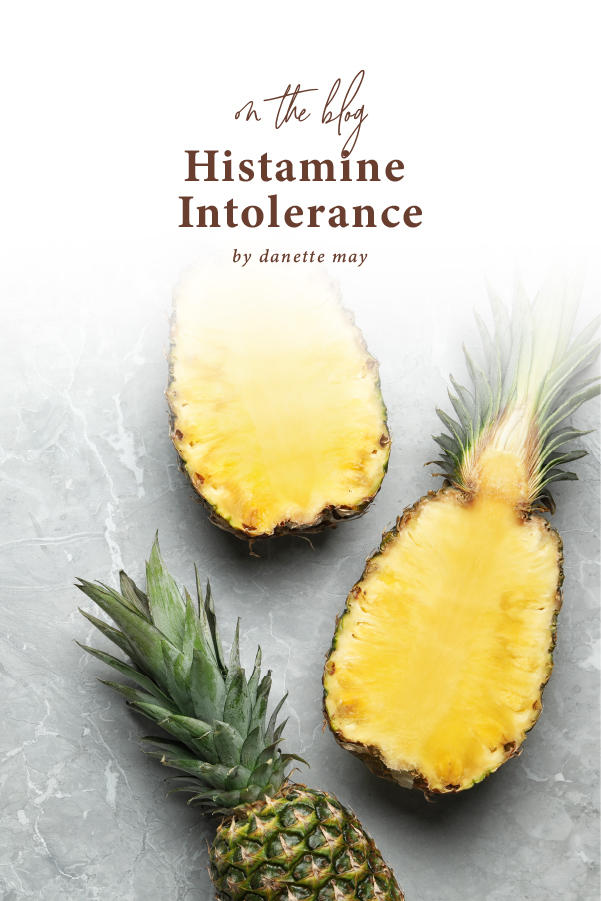Let’s talk histamine. It’s something you’re likely familiar with when it comes to allergy season, but histamine intolerance goes beyond those itchy eyes and scratchy throat. We’re talking anxiety, irregular periods, and get this—if you tend to get flushed after a glass of red, histamine may be to blame.
We’re sharing all the deets on exactly what you need to know about histamine intolerance, how to know if it’s something that’s affecting you, and what you can do about it now.
What is Histamine Intolerance?
First, let’s break down what histamine is. It’s a chemical that causes an inflammatory response when your body comes in contact with a threat (think pollen during allergy season). It also aids in digestion and sends messages from your body to your brain.
When your body produces histamine, it also produces DAO, also known as diamine oxidase. This enzyme plays the important role of breaking down excess histamine. However, if you have a DAO deficiency, this can quickly lead to a histamine buildup, aka histamine intolerance.
Histamine Symptoms You Need to Know About
So, how do you know if you have a build-up of histamine in your body? The first thing to know is that symptoms of histamine intolerance can really affect any area of the body as histamine travels throughout the bloodstream. Here are some of the most common signs and symptoms of histamine intolerance.
- Sneezing
- Congestion
- Hives
- Fatigue
- Headaches
- Dizziness
- Fast heart rate
- Skin flushing
- Abnormal periods
- Anxiety
- Digestive discomfort
Histamine Intolerances Causes
When it comes to histamine intolerance, there is no one simple answer when it comes to what causes it.
Some of the most common causes of histamine intolerance include digestive-related conditions like leaky gut, inflammatory bowel disease, or bacterial overgrowth.
4 Hacks to Tame Histamine Intolerance Symptoms
Ok, so you have histamine intolerance, now what? If you want relief from your symptoms ASAP, here are some hacks to help tame those uncomfortable histamine intolerance symptoms.
#1 Avoid High Histamine Foods
- Citrus fruits
- Papaya
- Pineapple
- Bananas
- Strawberries
- Smoked fish
- Aged cheese
- Sour cream
- Milk
- Cured meats
- Nuts
- Chocolate
- Avocados
- Eggplant
- Spinach
- Tomato
- Olives
- Mayonnaise
- Pickles
- Sauerkraut
- Kefir
- Yogurt
- soy sauce
- Vinegar
- Wine
- Beer
#2 Avoid DAO Blocking Beverages
Certain beverages are known to block DAO production, the enzyme responsible for breaking down histamine. If you have histamine intolerance, you may want to steer clear of alcohol, black tea, and green tea.
#3 Consider Enjoying Low Histamine Foods More Often
Consider swapping high histamine foods with some of these low histamine food options.
- Organic pasture-raised poultry
- Grass-fed meat
- Wild-caught fish
- Herbs
- Pears
- Apples
- Cantaloupe
- Brown rice
- Quinoa
- Eggs
- Coconut oil
- Olive oil
- Raw peanut butter
- Vegetables (minus the high histamine ones listed above)
#4 Addressing Underlying Causes
If gut health issues are at the root of your histamine symptoms, supporting gut health is key. Eliminating foods you may be sensitive to, and getting a daily dose of self-care in each day is always a good idea when trying to balance health!
Getting Your Histamine in Check
Remember, not everyone is sensitive to histamines. If you think histamine intolerance may be at the root of your symptoms, consider avoiding high histamine foods and enjoy low histamine foods more often. Avoiding foods high in histamine may be exactly what you need to drop that chronic sneeze, all day fatigue, and get back to feeling like yourself.
What's your favorite low histamine food? Let me know in the comments!
You might be also interested in:
6 Foods that Fight Seasonal Allergies
Wheat Free vs Gluten Free (there's a difference)
15 Foods that Could be Triggering Your Migraines







